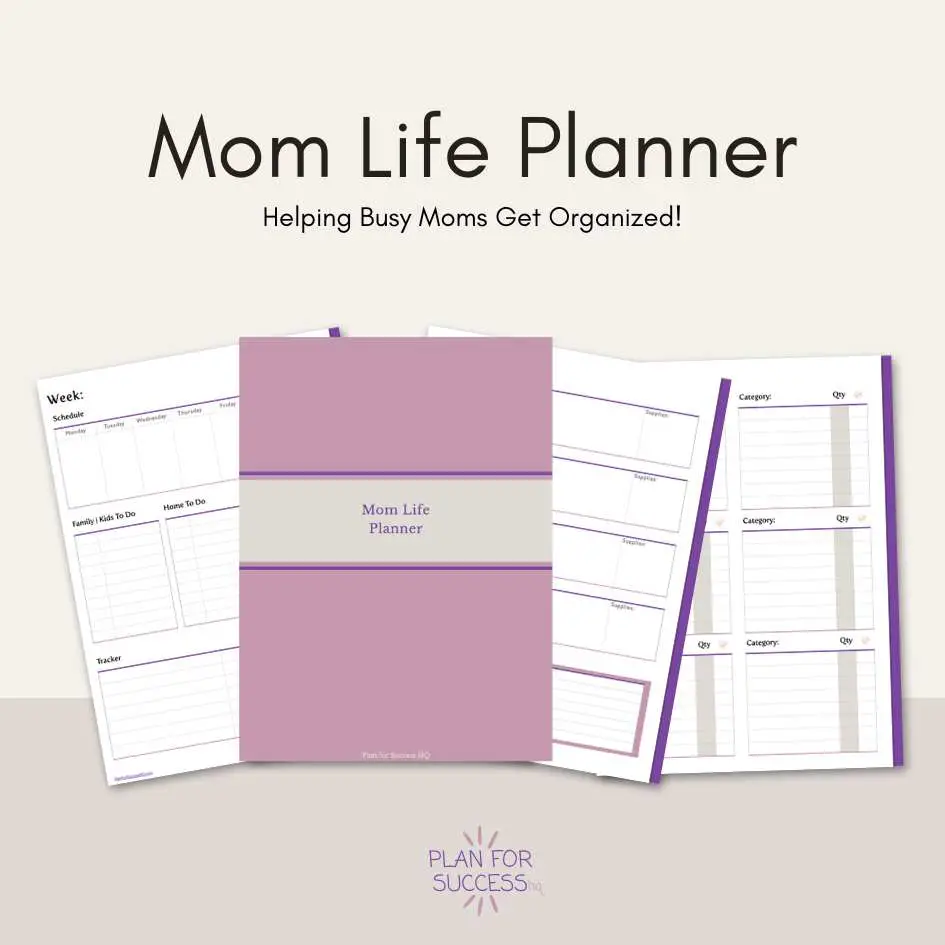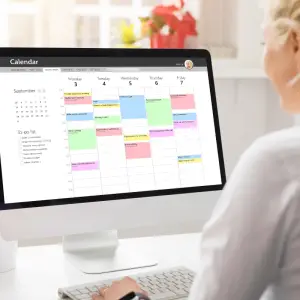In today’s fast-paced world, staying organized and productive is more important than ever. Did you know that using a digital planner can help you boost your productivity and streamline your tasks? In fact, in 2024, digital planners have become essential tools for enhancing productivity, with features that make planning and organization easier than ever before.
With customizable templates, cloud synchronization, and clickable hyperlinks, digital planners offer convenience and flexibility that traditional paper planners can’t match. You can access your plans from multiple devices, instantly download them, and even customize them to fit your unique needs. It’s the calendar app alternative you’ve been waiting for.
Key Takeaways:
- Using a digital planner can significantly enhance your productivity and streamline your tasks.
- Features like customizable templates, cloud synchronization, and clickable hyperlinks provide convenience and flexibility.
- Digital planners allow you to access your plans from multiple devices and customize them to fit your needs.
- With a digital planner, you can ditch the paper and go for a paperless planning experience.
- Maximize your efficiency and stay perfectly organized with the help of a digital planner.
Click here to seize control of your busy mom life with our Hyperlinked Mom Life Planner – your first step towards effortless organization!
What are Digital Planners and How Do They Differ from Traditional Planners?
Digital planners and traditional planners are two distinct methods of organizing tasks and schedules. While they serve the same purpose, they differ significantly in their features and functionalities.
A digital planner is an electronic tool designed for scheduling, task management, and daily organization. It offers advanced features that traditional planners cannot match, such as syncing with multiple devices, customizable templates, and automated reminders. With digital planners, users can easily access their schedules and plans from anywhere and at any time, thanks to cloud synchronization. They also have the convenience of instantly downloading and securely storing their plans in the cloud.
On the other hand, traditional planners are physical, printed tools that require manual writing of appointments and to-dos. Although they can be reliable and straightforward, they lack the versatility and convenience of digital planners. Traditional planners do not offer features like cross-device accessibility, customizable templates, or automated reminders. Users rely on physical copies, which can be easily lost, damaged, or inconvenient to carry.
The main distinction between digital planners and traditional planners is the transition from paper to digital. Digital planners enable a paperless planning experience, allowing users to embrace the benefits of technology and enjoy a more streamlined and efficient planning process. They provide the flexibility to customize layouts, easily edit and rearrange tasks, and incorporate clickable hyperlinks.
“Digital planners offer advanced features and convenience that traditional planners cannot match.”
With the digital landscape evolving rapidly, more individuals are opting for digital planners. They provide the advantages of paperless planning, making it easier to stay organized and focused in today’s fast-paced world. The accessibility, customization options, and cloud storage capabilities of digital planners set them apart and make them an ideal choice for modern individuals seeking optimal productivity and organization.
When making the transition from traditional to digital planning, it’s important to consider the unique features and benefits digital planners offer. The ability to access plans from multiple devices, the convenience of customizable templates, and the security of cloud storage are key advantages of digital planners. These features, combined with the ability to easily track tasks, set goals, and integrate with other productivity tools, make digital planners a powerful organizing tool in the digital age.
How Can Digital Planners Enhance Productivity in 2024?
In 2024, digital planners offer advanced features that can greatly enhance productivity. They provide AI-driven suggestions for time management, predictive scheduling, and personalized productivity insights. These features can automatically adjust schedules based on real-time events, integrate seamlessly with other digital tools and platforms, and provide data analytics to help users understand their productivity patterns and improve time management.
Digital planners empower individuals to make informed decisions about their schedules, prioritize tasks effectively, and optimize their workflows for maximum efficiency and work-life balance.
For example, with AI-driven suggestions, digital planners can analyze historical data and user preferences to recommend the optimal time slots for tasks. This feature takes the guesswork out of scheduling and helps individuals allocate their time more effectively.
“Digital planners with AI-driven suggestions can revolutionize the way we manage our time,” says Jane Thompson, a productivity expert. “The ability to receive personalized recommendations based on real-time data allows us to adjust our schedules and prioritize tasks more efficiently.”
Additionally, digital planners equipped with predictive scheduling capabilities can anticipate future events and proactively make adjustments to accommodate them. This feature ensures that users are prepared for upcoming appointments, deadlines, and commitments, keeping them on track and reducing the likelihood of missed opportunities.
The personalized productivity insights provided by digital planners enable users to gain valuable self-awareness and understand key trends in their work habits. With access to data analytics, individuals can identify their most productive times of the day, track progress towards goals, and pinpoint areas for improvement. Armed with these insights, users can make data-informed decisions to optimize their productivity and achieve better work-life balance.
A digital planner can provide a visual representation of how time is allocated, making it easier to identify gaps for leisure activities, personal development, or relaxation. By visualizing their schedules, users can ensure they are dedicating sufficient time to all aspects of their lives while maintaining a healthy balance.
Personalized Productivity Insights Table
| Data Analytics Metrics | Benefits |
|---|---|
| Time allocation breakdown | Identify time-consuming tasks and areas for optimization |
| Productivity patterns | Discover peak performance hours and adjust schedules accordingly |
| Goal tracking | Monitor progress towards set goals and milestones |
| Task completion rate | Identify bottlenecks and improve task management |
| Work-life balance | Visualize time distribution for work, personal activities, and relaxation |
Image: Digital Planner Productivity
Are Digital Planners Suitable for Everyone?
Digital planners are versatile tools that can be tailored to meet various needs, making them suitable for a wide range of users. Whether you’re a student, a professional, or someone looking to manage personal tasks more efficiently, digital planners can be customized to meet your specific requirements.
However, using digital planners does require a basic comfort level with technology and digital tools. Individuals who are less tech-savvy or prefer physical writing may find traditional paper planners more suitable for their needs. It’s essential to assess your comfort level with digital technology before deciding whether a digital planner is the right choice for you.
Despite the need for comfort with technology, digital planners offer a user-friendly interface and intuitive features that can be easily navigated. The learning curve for using a digital planner is relatively low, and with a little practice, anyone can become proficient in using this modern organizational tool.
I understand that some individuals may have concerns about the transition from a traditional paper planner to a digital one. It’s important to note that many digital planners provide features and functionalities that mimic the feel and experience of using a physical planner. For example, digital planners often include options to write or type directly onto the pages, simulate the turning of pages, and incorporate realistic handwriting effects.
Just as with any new tool or technology, it may take some time to become accustomed to a digital planner. However, the benefits and advantages offered by digital planners outweigh the initial learning curve, making it a worthwhile investment for individuals seeking enhanced productivity and organization.
With customization options, intuitive interfaces, and user-friendly designs, digital planners can be adapted to suit the needs of individuals from various backgrounds and preferences. Whether you prefer a minimalist layout, colorful designs, or specialized templates for specific tasks, digital planners can be tailored to your liking.
Moreover, digital planners provide the advantage of instant updates and changes. Unlike physical planners, where revisions require crossing out or erasing, digital planners allow for easy editing, rearranging, and rescheduling. This flexibility can save time and effort in managing your plans and tasks.
Accessibility and convenience
The accessibility and convenience offered by digital planners are another reason why they are suitable for a wide range of users. With a digital planner, you can access your plans anytime, anywhere, as long as you have an internet connection or a synced device. This means you can review your schedule, update your tasks, and make changes on the go, whether you’re at home, in the office, or traveling.
Furthermore, digital planners provide the ability to set reminders and notifications, ensuring that important deadlines and appointments are not forgotten or overlooked. These alerts can be customized to suit your preferences, whether you prefer gentle reminders or more robust notifications.
| Benefits of Digital Planners | Suitability |
|---|---|
| Customizable layouts and templates | ✓ |
| Convenient access from multiple devices | ✓ |
| Instant updates and changes | ✓ |
| Reminder and notification features | ✓ |
| Integration with other digital tools | ✓ |
It’s worth noting that while digital planners offer numerous benefits, they may not be the right fit for everyone. Individuals who prefer the tactile experience of physically writing on paper or those who find comfort and familiarity in traditional planners may find digital planners less appealing or suitable for their needs.
Before making a decision, consider your personal preferences and comfort level with digital tools. If you are already comfortable using digital devices and enjoy the convenience of technology, a digital planner may be an excellent choice for you. However, if you prefer the tactile experience of physically writing down your tasks or find comfort in the simplicity of a traditional planner, sticking with a paper-based system may be more suitable.
Ultimately, the suitability of a digital planner depends on your preferences, needs, and comfort level with technology. Evaluate your organizational needs, consider the benefits and features of digital planners, and decide what aligns best with your personal style and workflow.
What are Some Key Features to Look for in a Digital Planner in 2024?
When choosing a digital planner in 2024, there are several key features to consider. These features enhance the functionality and user experience of a digital planner, making it a valuable tool for staying organized and productive. Let’s explore the essential features to look for:
Cross-platform Syncing
Cross-platform syncing is a crucial feature that allows users to access their plans from multiple devices seamlessly. Whether you’re using a smartphone, tablet, or computer, a digital planner with cross-platform syncing ensures that all your data and schedules are up-to-date on every device. This feature enables you to stay organized and connected, no matter where you are.
AI-based Scheduling Assistance
An AI-based scheduling assistant is a game-changer for digital planners. This feature utilizes artificial intelligence algorithms to provide intelligent suggestions and optimize your schedules. The AI learns from your patterns, preferences, and priorities, helping you make informed decisions and save valuable time. With AI-based scheduling assistance, you can create efficient and personalized plans, tailored to your unique needs.
Integration Capabilities
Integration capabilities are essential for a digital planner to seamlessly connect with other productivity tools and apps. An integrated planner can sync with your existing calendar, email, and project management software. This feature eliminates the need to switch between different platforms, ensuring all your tasks, deadlines, and events are consolidated in one place. Integration capabilities simplify your workflow, improve collaboration, and enhance overall productivity.
Customizable Templates
A digital planner with customizable templates offers flexibility in designing the planner layout to suit your individual preferences. Whether you prefer a minimalist or a more colorful and vibrant design, customizable templates allow you to create a planner that resonates with your style and personality. This feature enables you to stay motivated and engaged with your planning process.
Interactive Checklists
Interactive checklists are an invaluable feature for tracking and managing tasks effectively. With interactive checklists, you can create dynamic task lists that can be easily updated, marked as complete, or moved based on your progress. This feature helps you stay focused on your goals, ensures nothing falls through the cracks, and provides a sense of accomplishment as you tick off completed tasks.
By considering these key features when selecting a digital planner in 2024, you can find a tool that meets your specific needs and enhances your productivity and organization. The next section will discuss the importance of data security when using digital planners.
How Secure are Digital Planners with Personal and Sensitive Information?
In 2024, digital planners have evolved to prioritize data security, making them a safe choice for storing personal and sensitive information. Reputable digital planners employ various security measures to safeguard user data, ensuring privacy and confidentiality.
Encryption technology is a fundamental component of digital planner security. By encrypting data, information is transformed into an unreadable format, making it inaccessible to unauthorized individuals. This encryption process provides an additional layer of protection, ensuring that even if data is intercepted, it remains secure.
Secure cloud storage is another crucial aspect of digital planner security. User data is stored on reliable cloud servers, which are designed to maintain a high level of security. These servers employ robust security protocols, including firewalls, access controls, and constant monitoring to prevent unauthorized access and data breaches.
Additionally, reputable digital planners regularly update their security measures to address newly identified vulnerabilities or emerging threats. These updates patch any security loopholes and ensure that user data remains protected against the latest threats and vulnerabilities.
Privacy policies are essential documents that outline how a digital planner handles user data. It is vital for users to review the privacy policies of any digital planner they choose, as these policies provide clarity on how data is collected, stored, and used. Understanding the privacy policy can help users make informed decisions about the security of their personal information.
While digital planners offer a high level of security, it is still important for users to exercise caution when storing and sharing information through any digital tool. This includes using strong, unique passwords for digital planner accounts and refraining from sharing sensitive data with untrusted sources.
By taking appropriate precautions and using reputable digital planners, individuals can confidently store and manage personal and sensitive information without compromising their security. With robust encryption, secure cloud storage, and privacy policies in place, digital planners provide a secure and convenient solution for keeping personal and sensitive information organized.
The Benefits of a Hybrid Planning System: Integrating Physical and Digital Planning
Integrating physical and digital planning methods offers a powerful hybrid system that maximizes efficiency by combining the strengths of both approaches. When it comes to physical planning, tools like paper planners provide a tactile experience that stimulates memory and creativity. On the other hand, digital planning offers unparalleled flexibility, searchability, and integration with other digital tools.
By combining the two methods, individuals can leverage the benefits of both physical and digital planning. The hybrid planning system involves using a physical planner for brainstorming and initial drafts, allowing the freedom to jot down ideas, sketch diagrams, and make personal connections. Then, the plans can be transferred and expanded in a digital format for more detailed planning, scheduling reminders, and tracking tasks.
The hybrid planning system brings about a host of benefits:
- Enhanced Organization: By integrating physical and digital planning, individuals have a comprehensive system that allows for seamless organization across different platforms. This cohesion ensures that tasks and schedules are effectively managed and tracked.
- Improved Memory and Engagement: The tactile experience of physical planning aids in memory retention and stimulates engagement. Ideas and plans that are initially written down on paper are more likely to be retained and acted upon.
- Increased Productivity: Digital planning offers features like reminders, notifications, and task prioritization, which enhance productivity. The combination of physical and digital planning allows individuals to leverage the advantages of both methods and maximize their efficiency.
- Adaptability for Various Tasks: Different tasks may require different approaches. A hybrid planning system allows individuals to choose the most suitable method for each task, whether it’s physical brainstorming or digital scheduling.
By embracing a hybrid planning system that integrates physical and digital planning, individuals can experience the best of both worlds. They can tap into the creativity and tactile experience of physical planning while enjoying the flexibility and convenience of digital tools.
“A hybrid planning system combines the strengths of physical and digital planning methods, resulting in an efficient and adaptable approach that maximizes productivity and organization.”
Tips for Syncing Physical Notebooks with Digital Planners
When it comes to syncing physical notebooks with digital planners, there are a few tips that can help you smoothly combine the two methods of planning. By following these strategies, you can ensure a seamless integration of your paper and digital planning systems, creating a cohesive and efficient hybrid planning experience.
- Maintain Consistent Layouts: To facilitate a smooth transition between your physical and digital planners, it’s essential to maintain consistent layouts. Use similar templates or formats in both planners to make it easier to transfer and update your plans.
- Schedule Regular Reviews: Set aside dedicated time to review and update your digital planner with any new information or changes from your physical notebook. This will help keep both planners synchronized and ensure that you have all the necessary details readily available.
- Take Photos or Scan Important Pages: To preserve important information from your physical notebook and have a backup in your digital planner, consider taking photos or scanning relevant pages. Store these images in your digital planner, making it easy to access and refer to them whenever needed.
By implementing these tips, you can seamlessly combine the benefits of both physical and digital planning methods, maximizing efficiency and staying organized.
Benefits of a Hybrid Planning System
Adopting a hybrid planning system by integrating physical and digital planning methods offers a balanced approach that maximizes efficiency. By combining the strengths of both methods, individuals can enhance their organizational skills and boost productivity.
The flexibility and accessibility of a hybrid system allow for creative tasks to be done on paper, while structured tasks can benefit from digital planning features. With physical planners used for daily priorities and digital planners for long-term planning, individuals can effectively manage their tasks and goals.
The tactile experience of physical planning aids in memory retention and engagement, while the visual reminders and alerts of digital planners ensure important deadlines are not missed. Overall, a hybrid planning system provides the best of both worlds and helps individuals stay on top of their tasks more efficiently.
The combination of physical and digital planning methods maximizes efficiency and allows individuals to leverage the benefits of both approaches.
Advantages of Physical Planning
- Enhances memory retention and engagement
- Allows for creative brainstorming and ideation
- Provides a tactile experience and sensory stimulation
Advantages of Digital Planning
- Offers flexibility and accessibility across devices
- Provides visual reminders and alerts for important deadlines
- Enables seamless integration with other digital tools and platforms
Comparison Table: Physical vs. Digital Planning
| Physical Planning | Digital Planning |
|---|---|
| Enhances memory retention | Provides visual reminders |
| Allows for creative brainstorming | Offers flexibility and accessibility |
| Provides a tactile experience | Enables seamless integration with other digital tools |
By embracing a hybrid planning system, individuals can reap the benefits of physical and digital planning approaches, creating a personalized system that maximizes efficiency and productivity. So why choose one method when you can have the best of both worlds?
Conclusion
In conclusion, using a digital planner offers numerous benefits for maximizing productivity and organization. The features of cross-platform syncing, AI-based scheduling assistance, and customizable templates make digital planners versatile and efficient tools for managing tasks and time effectively.
By integrating physical and digital planning methods in a hybrid system, individuals can combine the advantages of both approaches and enhance their productivity. Leveraging the strengths of each method allows for a balanced and personalized planning routine that meets specific needs.
Whether choosing a purely digital approach or adopting a hybrid system, using a digital planner can streamline tasks, boost productivity, and keep life perfectly organized in 2024.
FAQ
Why should I use a digital planner?
Using a digital planner offers numerous benefits for maximizing productivity and organization. Features like cross-platform syncing, AI-based scheduling assistance, and customizable templates make digital planners versatile and efficient tools for managing tasks and time effectively.
How do digital planners differ from traditional planners?
Digital planners are electronic tools that offer advanced features like syncing with multiple devices, customizable templates, and automated reminders. Traditional planners, on the other hand, are physical, printed tools where users manually write down their appointments and to-dos.
How can digital planners enhance productivity in 2024?
In 2024, digital planners provide AI-driven suggestions for time management, predictive scheduling, and personalized productivity insights. These features can automatically adjust schedules based on real-time events, integrate seamlessly with other digital tools and platforms, and provide analytics to help users understand their productivity patterns and improve time management.
Are digital planners suitable for everyone?
Digital planners can be customized to meet various needs, making them suitable for a wide range of users. However, individuals who are less tech-savvy or prefer physical writing may find traditional paper planners more suitable for their needs. It’s essential to assess your comfort level with digital technology before deciding whether a digital planner is the right choice for you.
What are some key features to look for in a digital planner in 2024?
When choosing a digital planner in 2024, key features to consider include cross-platform syncing, AI-based scheduling assistance, integration capabilities with other productivity tools, customizable templates, and interactive checklists. These features enhance the functionality and user experience of a digital planner.
How secure are digital planners with personal and sensitive information?
Most reputable digital planners prioritize data security in 2024. They utilize encryption technology, secure cloud storage, and regular security updates to protect user data. It’s crucial for users to review the privacy policies of the planner they choose and ensure they use strong passwords to enhance security.
What are the benefits of a hybrid planning system that integrates physical and digital planning?
Integrating physical and digital planning methods offers a balanced approach that maximizes efficiency. By combining the strengths of both methods, individuals can enhance their organizational skills and boost productivity. The flexibility and accessibility of a hybrid system allow for creative tasks to be done on paper, while structured tasks can benefit from digital planning features.
What are some tips for syncing physical notebooks with digital planners in a hybrid planning system?
Maintaining consistent layouts in both the physical and digital planners helps ensure a seamless transition between the two methods. Regular reviews should be scheduled to update the digital planner with any new information from the physical planner. It’s also beneficial to take photos or scan important pages from the physical planner and store them in the digital planner for reference and backup.
What are the benefits of a hybrid planning system that combines physical and digital planning?
Adopting a hybrid planning system by integrating physical and digital planning methods offers a balanced approach that maximizes efficiency. By combining the strengths of both methods, individuals can enhance their organizational skills and boost productivity. The tactile experience of physical planning aids in memory retention and engagement, while the visual reminders and alerts of digital planners ensure important deadlines are not missed.




